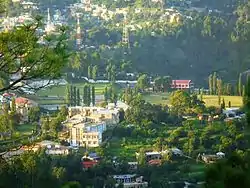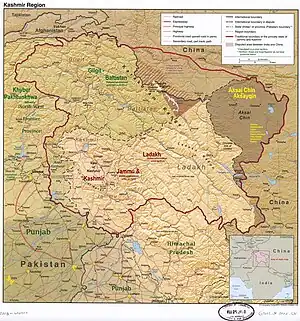Sudhanoti District
The Sudhanoti District (also spelled Sudhanuti District) (Urdu: ضلع سدھنوتی), meaning the "heartland of Sudhans" or "Sudhan heartland"),[3][4][5] is a district of Pakistan-administered Azad Kashmir in the disputed Kashmir region.[1] It is one of the 10 districts of Pakistan-administered dependent territory of Azad Kashmir.[6] The Sudhanoti District is bounded on the north and east by the Poonch District,[7] on the south by the Kotli District, and on the west by the Rawalpindi District of Pakistan's Punjab Province. It is located 90 kilometres (56 mi) from Islamabad, the capital of Pakistan. It is connected with Rawalpindi and Islamabad via the Azad Pattan Road.
Sudhanoti District
ضلع سدھنوتی | |
|---|---|
District of Azad Kashmir administered by Pakistan[1] | |
 A view of Cadet College Pallandri in the Sudhanoti District | |
Interactive map of Sudhanoti district | |
 A map showing Pakistani-administered Azad Kashmir (shaded in sage green) in the disputed Kashmir region[1] | |
| Coordinates (Pallandri Tehsil): 33°40′N 73°43′E | |
| Administering country | Pakistan |
| Territory | Azad Kashmir |
| Division | Poonch Division |
| Headquarters | Pallandri |
| Government | |
| • Type | District Administration |
| • Deputy Commissioner | N/A |
| • District Police Officer | N/A |
| • District Health Officer | N/A |
| Area | |
| • Total | 569 km2 (220 sq mi) |
| Population (2017) | |
| • Total | 297,584 |
| • Density | 523/km2 (1,350/sq mi) |
| Languages | |
| • Official | Urdu[2] |
| • Spoken | Gujari; Pahari-Pothwari |
| Time zone | UTC+5 (PST) |
| Number of Tehsils | 4 |
| Website | sudhanoti.com |
The district headquarters is the town of Pallandri. It is at an elevation of 1,372 meters and is at a distance of 97 kilometers from Rawalpindi via the Azad Pattan Road. Pallandri is connected to Rawalakot by a 64-km metaled road.

History
The word Sudhanoti literally means "heartland of Sudhans" Sudhan (tribe) Noti (heartland).
Sudhanoti, whose first name was Bhan Ya (Brahman) who was defeated by the Pashtun Sadozai invaders in the thirteenth century AD defeated the Bhagar Rajputs and named it Sudhanoti.[8] The state of Sudhanoti is one of the former ten states of Jammu and Kashmir, Its history is approximately one thousand twelve hundred years old which Sudhanoti was ruled by Brahmins from 830 to 1105 AD.
The Brahman Raj was invaded by the Rajputs of hill Punjab in 1005 and captured Sudhanoti in 1105, The Bhagar Rajputs ruled Sudhanoti from 1105 to 1360. The Bhagar Rajputs were then attacked by the Afghan chief named Nawab Jassi Khan in 1360 AD, defeating them and establishing their own Sadozai government.
The Sadozai tribe ruled Sudhanoti from 1360 to 1837, Sudhanoti which from 800 to 1837 was called the fully independent state of Sudhanoti, came to an end in the Third Sikh Sudhanoti War, in which fifty to thirty thousand Sadozai people were killed. The Sikh Khalsa merged with the state of Poonch and brought it under the control of the Lahore government.
Later from 1940 to 1947 it was a tehsil of Jammu province, Thereafter in 1947 Sudhanoti became the capital of the Azad Kashmir Revolutionary Government, which was the capital of the Azad Kashmir Revolutionary Government from 1947 to 1949.
After that in 1960 Sudhanoti was divided into four districts and Sudhanoti was made a district[9][10][11][12]
- Cultural Heritage Sudhanoti
- Fort In Pune
- Fort Bharand
- Fort Barel
- Fort Mandhol
Administrative divisions
Population
Sudhanoti has a population of 297,584 according to the 2017 Census.[14]
The main native language is Pahari, spoken by an estimated 95% of the population.[15][16]
Education
According to the Alif Ailaan Pakistan District Education Rankings 2017, Sudhanoti is ranked 34 out of 155 districts with a score of 68.85 in terms of education. For facilities and infrastructure, the district is ranked last with the very low score of 6.76.[17]
Educational institutes include:
- Mirpur University of Science & Technology (MUST) Pallandri campus, Sudhanoti District
- Mohi-ud-Din Islamic University Nerian Sharif, a chartered university situated 125 km west of Islamabad
- University of Poonch (SM campus, Mang, Sudhanoti District)
Notable people
- Kiran Imran Dar, Member National Assembly (MNA) Pakistan
- Aziz Khan, General of the Pakistan Army and Chairman of the Joint Chiefs of Staff Committee[18]
- Khan Muhammad Khan, Politician and the Chairman of the War Council during the 1947 Poonch Rebellion[19]
- Dr. Muhammad Najeeb Naqi Khan, Minister for Health and Finance. He was elected as a member of the Azad Kashmir Legislative Assembly five times (in 1991, 1996, 2006, 2011, and 2016) from the Pallandri constituency and was a member of the Kashmir Council from 2001 to 2006.
- Muhammad Alauddin Siddiqui was a great Islamic Sufi Scholar and 2nd custodian of Nerian Sharif, Tarar Khel. He died on 3 Feb 2017.
See also
References
- The application of the term "administered" to the various regions of Kashmir and a mention of the Kashmir dispute is supported by the tertiary sources (a) through (e), reflecting due weight in the coverage. Although "controlled" and "held" are also applied neutrally to the names of the disputants or to the regions administered by them, as evidenced in sources (h) through (i) below, "held" is also considered politicized usage, as is the term "occupied," (see (j) below).
(a) Kashmir, region Indian subcontinent, Encyclopaedia Britannica, retrieved 15 August 2019 (subscription required) Quote: "Kashmir, region of the northwestern Indian subcontinent ... has been the subject of dispute between India and Pakistan since the partition of the Indian subcontinent in 1947. The northern and western portions are administered by Pakistan and comprise three areas: Azad Kashmir, Gilgit, and Baltistan, the last two being part of a territory called the Northern Areas. Administered by India are the southern and southeastern portions, which constitute the state of Jammu and Kashmir but are slated to be split into two union territories.";
(b) Pletcher, Kenneth, Aksai Chin, Plateau Region, Asia, Encyclopaedia Britannica, retrieved 16 August 2019 (subscription required) Quote: "Aksai Chin, Chinese (Pinyin) Aksayqin, portion of the Kashmir region, at the northernmost extent of the Indian subcontinent in south-central Asia. It constitutes nearly all the territory of the Chinese-administered sector of Kashmir that is claimed by India to be part of the Ladakh area of Jammu and Kashmir state.";
(c) "Kashmir", Encyclopedia Americana, Scholastic Library Publishing, 2006, p. 328, ISBN 978-0-7172-0139-6 C. E Bosworth, University of Manchester Quote: "KASHMIR, kash'mer, the northernmost region of the Indian subcontinent, administered partlv by India, partly by Pakistan, and partly by China. The region has been the subject of a bitter dispute between India and Pakistan since they became independent in 1947";
(d) Osmańczyk, Edmund Jan (2003), Encyclopedia of the United Nations and International Agreements: G to M, Taylor & Francis, pp. 1191–, ISBN 978-0-415-93922-5 Quote: "Jammu and Kashmir: Territory in northwestern India, subject to a dispute between India and Pakistan. It has borders with Pakistan and China."
(e) Talbot, Ian (2016), A History of Modern South Asia: Politics, States, Diasporas, Yale University Press, pp. 28–29, ISBN 978-0-300-19694-8 Quote: "We move from a disputed international border to a dotted line on the map that represents a military border not recognized in international law. The line of control separates the Indian and Pakistani administered areas of the former Princely State of Jammu and Kashmir.";
(f) Skutsch, Carl (2015) [2007], "China: Border War with India, 1962", in Ciment, James (ed.), Encyclopedia of Conflicts Since World War II (2nd ed.), London and New York: Routledge, p. 573, ISBN 978-0-7656-8005-1,The situation between the two nations was complicated by the 1957–1959 uprising by Tibetans against Chinese rule. Refugees poured across the Indian border, and the Indian public was outraged. Any compromise with China on the border issue became impossible. Similarly, China was offended that India had given political asylum to the Dalai Lama when he fled across the border in March 1959. In late 1959, there were shots fired between border patrols operating along both the ill-defined McMahon Line and in the Aksai Chin.
(g) Clary, Christopher, The Difficult Politics of Peace: Rivalry in Modern South Asia, Oxford and New York: Oxford University Press, p. 109, ISBN 9780197638408,Territorial Dispute: The situation along the Sino-Indian frontier continued to worsen. In late July (1959), an Indian reconnaissance patrol was blocked, "apprehended," and eventually expelled after three weeks in custody at the hands of a larger Chinese force near Khurnak Fort in Aksai Chin. ... Circumstances worsened further in October 1959, when a major class at Kongka Pass in eastern Ladakh led to nine dead and ten captured Indian border personnel, making it by far the most serious Sino-Indian class since India's independence.
(h) Bose, Sumantra (2009), Kashmir: Roots of Conflict, Paths to Peace, Harvard University Press, pp. 294, 291, 293, ISBN 978-0-674-02855-5 Quote: "J&K: Jammu and Kashmir. The former princely state that is the subject of the Kashmir dispute. Besides IJK (Indian-controlled Jammu and Kashmir. The larger and more populous part of the former princely state. It has a population of slightly over 10 million, and comprises three regions: Kashmir Valley, Jammu, and Ladakh.) and AJK ('Azad" (Free) Jammu and Kashmir. The more populous part of Pakistani-controlled J&K, with a population of approximately 2.5 million.), it includes the sparsely populated "Northern Areas" of Gilgit and Baltistan, remote mountainous regions which are directly administered, unlike AJK, by the Pakistani central authorities, and some high-altitude uninhabitable tracts under Chinese control."
(i) Fisher, Michael H. (2018), An Environmental History of India: From Earliest Times to the Twenty-First Century, Cambridge University Press, p. 166, ISBN 978-1-107-11162-2 Quote: "Kashmir’s identity remains hotly disputed with a UN-supervised “Line of Control” still separating Pakistani-held Azad (“Free”) Kashmir from Indian-held Kashmir.";
(j) Snedden, Christopher (2015), Understanding Kashmir and Kashmiris, Oxford University Press, p. 10, ISBN 978-1-84904-621-3 Quote:"Some politicised terms also are used to describe parts of J&K. These terms include the words 'occupied' and 'held'." - Rahman, Tariq (1996). Language and politics in Pakistan. Oxford University Press. p. 226. ISBN 978-0-19-577692-8.
- Watch (Organization), Human Rights (2006). Pakistan, with Friends Like These. Human Rights Watch.
- Human Rights Watch: "With Friends Like These...". Human Rights Watch.
- Talbot, Ian (2016-01-28). A History of Modern South Asia: Politics, States, Diasporas. Yale University Press. ISBN 978-0-300-21659-2.
- "AJ&K Portal". www.ajk.gov.pk.
- "Subdivisions of AJK".
- Wikeley, J. M. (1968). Punjabi Musalmans. Pakistan National Publishers.
- History of the Punjab Hill States by Hutchison and Vogel, reprinted edition, 2 volumes in 1 Chapter XXIV. 1933 AD
- Balocu, Nabī Bak̲h̲shu K̲h̲ānu (1989). Maulānā Āzād Subḥānī: taḥrīk-i āzādī ke ek muqtadir rahnumā (in Urdu). Idārah-yi Taḥqīqāt-i Pākistān, Dānishgāh-i Panjāb. ISBN 978-969-425-071-7.
- Snedden, Christopher (2013). Kashmir: The Unwritten History. India: Harper Collins Publishers. ISBN 978-9350298978.
- "Statistical Year Book 2019" (PDF). Statistics Azad Jammu and Kashmir. Archived (PDF) from the original on 30 June 2020. Retrieved 20 April 2020.
- "Tehsils of Sudhnoti District on AJK map". ajk.gov.pk. AJK Official Portal. Retrieved 19 November 2019.
- "Census 2017: AJK population rises to over 4m". The Nation. Retrieved 2017-09-01.
- Statistical Year Book 2020 (PDF). Muzaffarabad: AJ&K Bureau Of Statistics. p. 140. Retrieved 3 March 2022.
- Shakil, Mohsin (2012). "Languages of Erstwhile State of Jammu Kashmir (A Preliminary Study)". p. 12.
- "Pakistan District Education Rankings 2017" (PDF). elections.alifailaan.pk. Alif Ailaan. Retrieved 19 November 2019.
- Bhattacharya, Samir (2014). NOTHING BUT!. Partridge Publishing. p. 228. ISBN 978-1-48281-787-4.
- "Introduction". Khan Sahib Government College of Technology, Rawalkot. Retrieved 14 October 2018.
External links
- Government of Azad Jammu and Kashmir
 Azad Jammu and Kashmir travel guide from Wikivoyage
Azad Jammu and Kashmir travel guide from Wikivoyage
